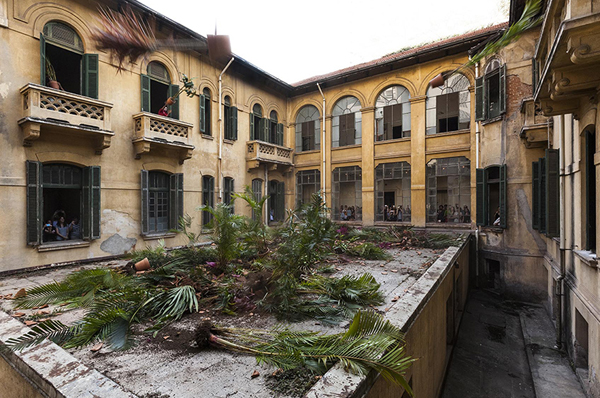Can the world change in two minutes? Héctor Zamora’s O Abuso da História reveals a wild art performance that feels like it could be an odd, spontaneous protest riot. Various camera angles survey an elegant, old world Latin American colonial-vintage courtyard. Suddenly, large potted plants rain down, hurled from its windows. These crash to bits upon impact, remaining both living and near dead. The finale surveys the ambiguous wreckage while viewers experience a reflex to want to see all 120 seconds of the video all over again.
Zamora’s recent masterwork will be screened at Maczul’s Multimedia Room for two months, starting July 30. This is part of Global Visions: Insights into Inernational Moving Image Art, a program created by Backroom Caracas and curated by Kelly Gordon, with support from the Office of Public Affairs at the Embassy of the United States in Caracas, and a collaboration alliance with Maczul, Centro de Arte Los Galpones, Hacienda La Trinidad Parque Cultural and, on this occasion, thanks to Luciana Brito Gallery in São Paulo and private collector Manuel de Santaren. The work will also be shown in Caracas upcoming July 28 at Centro de Arte Los Galpones.
Héctor Zamora (Mexico DF, 1974) currently lives and works in Lisbon. Although his academic training was in graphic arts, his current practice spans performance, video, sculpture and outdoor installations. Internationally renown, his best known works involve interventions in public settings, environments devised with structures, and actions or assemblages that call attention to patterns of use and perception in public spaces.
Zamora’s legacy to date focuses on the perpetually inventive ways he engages audiences with subversive means, ideas, imagery and interventions. His works characteristically re-imagine an extant setting, imbuing it with new, unforgettable and multivalent inference.
The Abuse of History
Set in the São Paulo courtyard of the Hospital Matarazzo, a colonial-style, vintage, former asylum slated for demolition, O Abuso da História was shot on this site when it was on the brink of being leveled and replaced by a shopping mall. The video was conceived not only as a record of the live performance but also as a stand-alone artwork, beyond its role as documentation. Multiple vantage points capture the action in ways witnesses could not observe as the drama actually unfolded.
Shocking, compelling, absurd, mysterious, metaphorical, simultaneously tragic, hilarious, sad and cathartic, the video parallels the spirit of several video works by contemporary Brasilian artists who utilize an act of destruction to probe broader commentaries. The slippery disappearance of history, the persistence of dire socio-economic conflict and the issues and power surrounding promised “progress”, “growth” and “renewal” are among their shared concerns.
In the extended title of the work the artist quotes Michel Foucault:
I do not think that there is anything that is functionally—by its very nature—absolutely liberating. Liberty is a practice (…) If one were to find a place, and perhaps there are some, where liberty is effectively practiced, one would find that it is not it owing to the order of objects, but once again, owing to the practice of liberty.
Profoundly and mysteriously watching O Abuso da História liberates viewer’s perceptions—at least about changes that can transpire in two minutes.
About the artist:
Héctor Zamora (Mexico DF, 1974) is a contemporary artist based in Lisbon. Studied Graphic Design but his current practice spans performance, video, sculpture and outdoor installations. The artist’s video, sculptural and architectural work has been featured in two Venice Biennales, at the Triennial in Nagoya, Japan, and biennials in Cairo, São Paulo, Istanbul, Shenzhen, Liverpool, Lyon and Havana. He participated in the BMW Guggenheim Labs in Mumbai. He has been part of several group exhibitions worldwide. Zamora’s recent solo exhibitions were Ordre et Progrès, Palais de Tokyo, París (2016); La réalité et autres tromperies, FRAC des Pays de la Loire, Nantes (2015); Héctor Zamora [documentary videos], Kunststation Delden/ Het-Loket, Holanda (2014). He is currently working on comissiones projects for Fundación RAC (Pontevedra), Raiffeisen Bank (Geneva), and Kista Äng (Stockholm). Ivan Muniz Reed will provide a study of Zamora’s works for Civic Actions: Artist’s Practices Beyond the Museum, a book commissioned by the MCA of Australia, drawn from proceedings at a 2015 conference on socially engaged art, published July 2016.
Artist’s website: lsd.com.mx

















